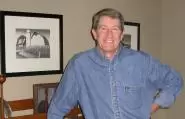Each Journey Leads To a New Discovery
My latest little journey took me down to Shreveport, Louisiana, this past week.
From my hotel room overlooking the Red River, which on this particular day was dark brown and in a rush to get to New Orleans, I could see four bridges: two sleek concrete forms spanning the interstate highway, an old narrow, rusty railroad bridge still in use by the Norfolk Southern, and a riveted, steel bridge painted battleship gray and proudly giving credit to Governor Huey Long for its construction in 1934.
(My first thought, as I read the plaque, was how much the notorious governor had probably taken in kickbacks as he handed out the contracts for that plum project.)
Shreveport is an old river town, its downtown district now on life support provided by the riverfront casinos, a few government offices and a half dozen moderate high-rise office buildings home to the town’s major banks. All but a few retail shops and restaurants have fled to the safety of the outskirts of the city, leaving behind boarded up storefronts and a smattering of bars and nightclubs competing for the stragglers making their way home from the casinos with a few dollars still left in their wallets.
I was touring the downtown district at 6:30am in my running shoes, sharing the sidewalks with a few pigeons, a street-cleaning crew and a few homeless men using their backpacks as pillows. I had crossed over on Huey Long’s bridge connecting downtown Shreveport with its riverside neighbor, Bessier City, and had no idea what to expect as I jogged from traffic signal to traffic signal.
And there, amid the bricks, asphalt and concrete, appeared a green oasis: a lush city block of manicured grass framing a spotless, poured concrete Art Deco gem, the Caddo Parish Courthouse. Begun in 1926 and completed in 1928, its architect had been Edward F. Neild, whom I had never heard of.
It seems that President Harry Truman had later seen Edward Neild’s Art Deco courthouse in Shreveport and liked it. Years later he recommended Neild for the position of architect for the new Jackson County Courthouse in Kansas City, Missouri. He also utilized Neild for construction work done on the White House during Truman’s administration.
In 1955, Truman tapped Edward Neild to design the Truman Library on a knoll in Independence, overlooking Kansas City. Although Truman had envisioned a library inspired by his grandfather’s home in Grandview, Neild went a different direction.
When reporter for the New York Times observed at the dedication in 1957 that the building reflected the influence of Frank Lloyd Wright, who was then at work on the Guggenheim Museum, Truman is said to have replied, “Its got too much of that fellow in it to suit me.”
I guess you can’t please ’em all, even if you’re as famous as Frank Lloyd Wright.

Until next Monday,
Have a great week!
– Bruce
